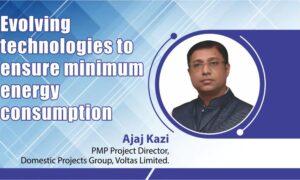We are going to achieve our vision of a low carbon world. So, looking at it going forward, the buildings are going to open up.
New normal and important points of indoor air quality
I think one of the things in the whole thing is that while we speak about making our indoor safe, the most important thing which everybody is saying is to bring the outdoors inside – that implies bringing the fresh air inside, which is what we have been missing.
Today, in this industry we operate with design in a way as if we’re indoors, everything is so tightly shut. I’m saying why we don’t look from inside out and look at a new perspective! How about using the outdoor environment more!
India is a country which gets a great climate around the year. It’s only a few months of hot season that we get. Why do we need air conditioning for the rest of the time? So with a completely different perspective, I stress understanding the indoor and outdoor thermal comfort and how that can be useful for combating, such as operating, maintaining filters. Let’s question ourselves. I just want to give some context why we need to think a little differently. If we continue the way we are continuing there is no way we are going to achieve what our vision is of a low carbon world.
The amount of construction that is happening and what is driving it; of course, the urbanisation that is taking place, we are expected to reach about 40 percent urbanisation in the next decade from now. But what would that mean? That would mean cities which are huge, and the population there is huge. Just to give you an idea, Delhi would be the most populated city by 2030, we will have 39 million people-40 million people staying there.
What is driving this construction boom of course! While the world is concentrating on renovating their infrastructure, or making buildings here and there, we are making cities, airports, railway stations and all. Given that fact, whatever we have done in the green building movement, of course, is a commendable progress of going nearly 8 billion sq. ft., as the Indian Green Building Council recently released figures, but that’s not going to be adequate because these green buildings are still just what we call the tip of the iceberg. If I look at a city like Bangalore; the city was in terms of greenery in 1970. As such Bangalore is an air-conditioned city. It has the ideal climate. The land surface temperature itself has gone up by nearly two and a half degrees. If we have to reverse this, if we have to enter into a low carbon world, just going the conventional way of air conditioning; the way of looking at the things of designing our air conditioning systems, are not going to work. I want to introduce a concept of what we call a field like temperature or as the technical term that we use is universal thermal climate index (UTCI) which is about what we feel when we are outside.
For example, if you stand outside in the big summer with ambient temperatures 45 degrees centigrade, your field is like a hot wind and the hot sun is going to maybe about 60 degrees centigrade. So a field like temperature has a great connotation that we need to understand. The combination of four- right temperature, relative humidity, shade and wind speed is a key that one can look at.
Now this is something that we very successfully have been experimenting with. And, we have seen that the fields like temperatures have dropped by using the shading devices, by using vegetation, by using water etc., and validating the performance using the simulation tools. I just want to bring it out from something like in a place in Bangalore where a project we are doing is -from a field like temperature 37 degrees centigrade, bringing down to 26 degrees centigrade in the same space. Now that you are more comfortable outdoors, obviously people will tend to go out. The fear of staying indoors with Corona of course gets minimised because you’re enjoying the space outdoors more.
The four parameters
The same logic applies to indoors which is what we call an indoor thermal comfort. We all have traditionally followed ASHRAE standard 55 and looked at it by saying that – this is the temperature condition specified and we are going for 20 degrees 21 degrees 22 degrees centigrade temperature, not realising that the standard 55 or the concept of thermal comfort again rotates around the four parameters, shade, temperature, relative humidity, wind speed is what they’re looking at.
The relationship between those parameters defines how comfortable you are indoors. That is the indoor Environmental Quality Standard IEQ, which I chaired and in 2019 we came out of the second version of it, where we have actually classified the building in terms of the indoor thermal comfort as Class A, B and C. Class C being the minimum acceptable requirement and Class A being the inspirational. There again, the relationship is within temperature, relative humidity and the air speed. And it has proven that you can actually elevate the indoor temperature.
In the wellness standard, the IGBC health and wellbeing standard makes reference to the ISHRAE indoor Environmental Quality Standard. And that concept is there. So from my perspective and looking at it going forward, the buildings are going to open up. The best way to make sure is we are free from future pandemics also because outdoor air is what we need. In fact, operation theatres are the areas where we are looking for a Covid free environment. Why can’t we open up the buildings to allow the fresh air to come in most of the time? Only when it starts getting warm, we have fans running there, possibly that will be enough. Further, there is a great way of mixing outdoors with indoors. The concept of using HVLS fans has already started coming into the country and people are trying out the officers using the same concept.
Going by the concept of free cooling air, economizers is something that we need to bring back and even bring back the evaporative cooling because with the advent of double state of operated cooling, we can actually get very low temperatures using those. In my own office, I’ve done that. We have ensured that we are sitting away from the windows so that there is no direct gain. We’ve got windows which are labelled. We have fans in our office. So we have air conditioners and fans. We open the windows when the weather is right. In fact, from October till March, we don’t even switch on air conditioners. It’s not required, but just fresh air running there. And we maintain a temperature of 27 degrees in our office. It’s quite possible to do all of that. And that is what true sustainability and the green will be all about. That is how if you want to move towards a better indoor environment, low carbon world, I think that’s what we need to do. And that’s what true sustainability would be.
Cookie Consent
We use cookies to personalize your experience. By continuing to visit this website you agree to our Terms & Conditions, Privacy Policy and Cookie Policy.















